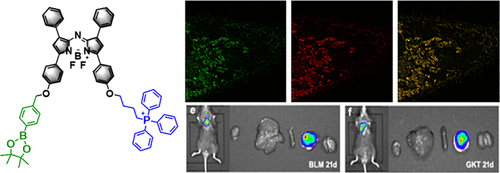Our official English website, www.x-mol.net, welcomes your
feedback! (Note: you will need to create a separate account there.)
Real-Time Evaluation of Hydrogen Peroxide Injuries in Pulmonary Fibrosis Mice Models with a Mitochondria-Targeted Near-Infrared Fluorescent Probe
ACS Sensors ( IF 8.2 ) Pub Date : 2021-01-28 , DOI: 10.1021/acssensors.0c02519 Xinyu Song 1, 2, 3 , Song Bai 1 , Na He 1 , Rui Wang 2 , Yanlong Xing 2 , Changjun Lv 1 , Fabiao Yu 2
ACS Sensors ( IF 8.2 ) Pub Date : 2021-01-28 , DOI: 10.1021/acssensors.0c02519 Xinyu Song 1, 2, 3 , Song Bai 1 , Na He 1 , Rui Wang 2 , Yanlong Xing 2 , Changjun Lv 1 , Fabiao Yu 2
Affiliation

|
Pulmonary fibrosis is a fatal chronic lung disease, leading to poor prognosis and high mortality. Accumulating evidence suggests that oxidative stress characterized by excessive production of hydrogen peroxide (H2O2) is an important molecular mechanism causing pulmonary fibrosis. We conceive a new type of mitochondria-targeted near-infrared fluorescent probe Mito-Bor to investigate changes in the level of endogenous H2O2 in living cells and mice models with pulmonary fibrosis. In the design strategy of the Mito-Bor probe, we selected azo-BODIPY as the fluorophore owing to its near-infrared fluorescence, strong photochemical stability, and low biological toxicity. Under physiological conditions, the response moiety 4-bromomethylphenylboronic acid pinacol ester could easily detect H2O2, and turn the fluorescence switch on. The modification of the lipophilic triphenylphosphine cation on the fluorophore would allow the probe to easily pass through the phospholipid bilayer of cells, and the internal positive charge could contribute to the selectivity of the mitochondria accumulation. The Mito-Bor probe provides high selectivity, low limit of detection, high biocompatibility, and excellent photostability. It can be used to detect changes in the level of H2O2 in living cells and in vivo. Therefore, the probe is applied to investigate the fluctuation of the H2O2 level during the process of inducing pulmonary fibrosis in cells, with changes in its fluorescence intensity correlating with the concentration of H2O2 and indicating the level of oxidative stress in fibroblasts. Conversely, pulmonary fibrosis can be modulated by adjusting the level of H2O2 in cells. A further study in mice models of bleomycin-induced pulmonary fibrosis confirms that NADPH oxidase 4 (NOX4) acts as a “button” to regulate H2O2 levels. The direct inhibition of NOX4 can significantly reduce the level of H2O2, which can delay the progression of lung fibrosis. These results provide an innovative way for the clinical treatment of pulmonary fibrosis.
中文翻译:

使用线粒体靶向的近红外荧光探针实时评估肺纤维化小鼠模型中的过氧化氢损伤。
肺纤维化是一种致命的慢性肺疾病,导致预后不良和高死亡率。越来越多的证据表明,以过氧化氢(H 2 O 2)过量产生为特征的氧化应激是引起肺纤维化的重要分子机制。我们构想了一种新型的针对线粒体的近红外荧光探针Mito-Bor,以研究内源性H 2 O 2的水平变化肺纤维化的活细胞和小鼠模型中的表达。在Mito-Bor探针的设计策略中,由于偶氮-BODIPY具有近红外荧光,强大的光化学稳定性和较低的生物毒性,因此选择其作为荧光团。在生理条件下,响应部分4-溴甲基苯基硼酸频哪醇酯可以很容易地检测到H 2 O 2。,然后打开荧光开关。荧光团上亲脂性三苯基膦阳离子的修饰将使探针易于穿过细胞的磷脂双层,并且内部的正电荷可能有助于线粒体积累的选择性。Mito-Bor探针具有高选择性,低检测限,高生物相容性和出色的光稳定性。它可用于检测活细胞和体内H 2 O 2含量的变化。因此,该探针可用于研究诱导细胞肺纤维化过程中H 2 O 2的水平变化,其荧光强度的变化与H的浓度相关。2 O 2表示成纤维细胞中的氧化应激水平。相反,可以通过调节细胞中H 2 O 2的水平来调节肺纤维化。在博来霉素诱导的肺纤维化小鼠模型中的进一步研究证实,NADPH氧化酶4(NOX4)充当调节H 2 O 2水平的“纽扣” 。直接抑制NOX4可以显着降低H 2 O 2的水平,从而可以延迟肺纤维化的进程。这些结果为临床治疗肺纤维化提供了一种创新的方法。
更新日期:2021-03-26
中文翻译:

使用线粒体靶向的近红外荧光探针实时评估肺纤维化小鼠模型中的过氧化氢损伤。
肺纤维化是一种致命的慢性肺疾病,导致预后不良和高死亡率。越来越多的证据表明,以过氧化氢(H 2 O 2)过量产生为特征的氧化应激是引起肺纤维化的重要分子机制。我们构想了一种新型的针对线粒体的近红外荧光探针Mito-Bor,以研究内源性H 2 O 2的水平变化肺纤维化的活细胞和小鼠模型中的表达。在Mito-Bor探针的设计策略中,由于偶氮-BODIPY具有近红外荧光,强大的光化学稳定性和较低的生物毒性,因此选择其作为荧光团。在生理条件下,响应部分4-溴甲基苯基硼酸频哪醇酯可以很容易地检测到H 2 O 2。,然后打开荧光开关。荧光团上亲脂性三苯基膦阳离子的修饰将使探针易于穿过细胞的磷脂双层,并且内部的正电荷可能有助于线粒体积累的选择性。Mito-Bor探针具有高选择性,低检测限,高生物相容性和出色的光稳定性。它可用于检测活细胞和体内H 2 O 2含量的变化。因此,该探针可用于研究诱导细胞肺纤维化过程中H 2 O 2的水平变化,其荧光强度的变化与H的浓度相关。2 O 2表示成纤维细胞中的氧化应激水平。相反,可以通过调节细胞中H 2 O 2的水平来调节肺纤维化。在博来霉素诱导的肺纤维化小鼠模型中的进一步研究证实,NADPH氧化酶4(NOX4)充当调节H 2 O 2水平的“纽扣” 。直接抑制NOX4可以显着降低H 2 O 2的水平,从而可以延迟肺纤维化的进程。这些结果为临床治疗肺纤维化提供了一种创新的方法。











































 京公网安备 11010802027423号
京公网安备 11010802027423号